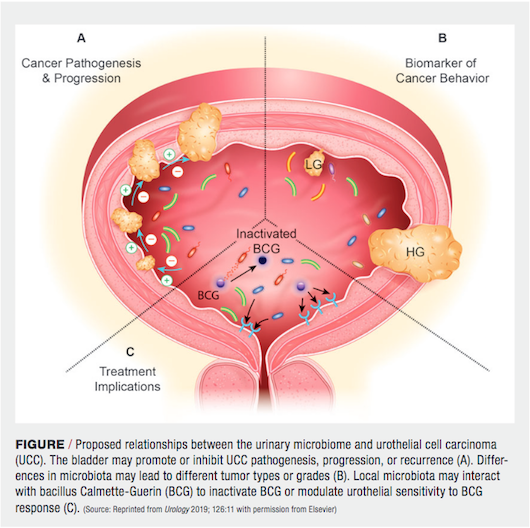Article
Bladder Ca biomarkers and BCG: New knowledge of the urinary microbiome
Author(s):
Study findings have implications for noninvasive markers to predict the course of UCC
A great challenge in the management of high-grade nonmuscle-invasive bladder cancer (NMIBC) is the detection of disease recurrence and progression following induction bacillus Calmette-Guerin (BCG) therapy. Moreover, predicting disease responsiveness to BCG has remained elusive. Current gold standard follow-up involves regular cystoscopic evaluation with visual inspection for disease recurrence. Although cystoscopy is associated with minimal morbidity, it remains invasive, and detection of recurrence is surgeon dependent.
Given the limitations of cystoscopy, a multitude of complementary tests (urine cytology, fluorescence in situ hybridization, cytokine and genetic profiling) have been investigated as potential biomarkers to predict NMIBC responsiveness, recurrence, and progression. Unfortunately, a sensitive and specific biomarker for NMIBC has not been discovered.
Also see: Sipuleucel-T cost lower vs. oral drugs over time
Our understanding of NMIBC biomarkers and BCG therapy has relied on the historical dogma that urine is sterile. However, recent advances in microbial detection have greatly expanded our knowledge of bacterial communities within the human body. Using enhanced culture techniques and DNA sequencing technology, live bacteria and bacterial DNA have been identified in urine samples deemed “culture negative” using standard clinical microbiology techniques (J Clin Microbiol 2012; 50:1376-83). Initial investigations in female patients supported the hypothesis that certain bacterial communities provide protection and that disruption of these communities may cause lower urinary tract symptoms (MBio 2014; 5:e01283–14). Subsequent investigation led to similar findings in men, with increased bacterial detection in more symptomatic patients (Eur Urol Focus Aug 21, 2018 [Epub ahead of print]).
Links between microbiome, disease
These relationships between microbes and symptoms have led to considerable excitement about the potential for previously uncharacterized relationships between the urinary microbiome and other urologic diseases, including bladder cancer.
The role of microorganisms as carcinogens is widely understood in the gastrointestinal tract. Infection and chronic gastric inflammation associated with Helicobactor pylori is a strong risk factor for gastric malignancy and esophageal adenocarcinoma. Moreover, dysbiosis of the colonic microbiome has been implicated in development of colorectal cancers.

In the genitourinary system, schistosomiasis and recurrent urinary tract infection are known factors in the development of squamous cell carcinoma of the bladder. However, interactions between microbes and the development of urothelial cell carcinoma (UCC) have not been characterized. It is feasible that urinary tract dysbiosis may influence the development of malignancy, and recent urinary microbiome investigations have paved the way for an exciting new area of bladder cancer research (Urology 2019; 126:10-5).
While investigation into the association of the urinary microbiome and NMIBC is in its infancy, initial studies have associated patients at high risk for UCC pathogenesis and progression with enrichment of certain bacterial communities (Front Cell Infect Microbiol 2018; 8:167). Unfortunately, the studies to date on this topic have been limited by their design, with all being case control studies with heterogeneous patient populations and small sample sizes.
Despite the limitations of these studies, their findings have exciting implications. There is a significant need for noninvasive biomarkers to predict the clinical course of UCC, and the possibility of using the urinary microbiome for risk stratification is highly intriguing. Further investigation of the relationship between the urinary microbiome and UCC may also shed light on pathophysiologic mechanisms and assessing response to therapy (figure).
Next: Implications for treatmentImplications for treatment
In a more direct sense, urologists have been manipulating the urinary microbiome to treat UCC for decades. Since the 1990s, instillation of BCG, an attenuated form of the bacterium Mycobacterium bovis, has been the gold standard for intravesical therapy of nonmuscle-invasive UCC. BCG presumably relies on an immune interaction between the BCG bacterium and the urothelium. The variability of responsiveness to therapy as well as the current national BCG shortage raise the question, “Can we harness the urinary microbiome to better treat UCC?”
In the past, urologists have made numerous efforts to utilize the bladder environment to predict and potentiate the effects of BCG. Various molecular biomarkers, immune cell response characteristics, and cytokine profiles have been investigated to predict BCG responsiveness. To date, no biomarker has shown high enough predictive value to warrant widespread clinical use (Eur Urol 2018; 73:738-48). With regard to potentiating BCG effects, adding interferon to BCG treatments attempts to modulate the bladder’s immune response. Modifying the bladder microbiome before or during BCG therapy may be a means to the same end.
Read: Pembro shows promising antitumor activity
The implications of the urinary microbiome on BCG therapy are unknown. It is plausible that certain bacteria may interact with the bladder to make the urothelium more or less susceptible to BCG binding. Furthermore, certain microbes may directly inactivate instilled BCG in the bladder, thereby reducing immunoinflammatory response.
Lastly, persistence of BCG in the bladder following therapy may serve as a biomarker for treatment success. If any of these theoretical mechanisms are true, it is feasible that the urinary microbiome might be harnessed to enhance BCG response or to facilitate an immune response using a novel treatment modality (BJU Int 2019; 124:7-8).
Conclusion
Our growing understanding of the urinary microbiome necessitates a complete reevaluation of the management of urologic disease, NMIBC included. With countless patients undergoing treatment for UCC every day and with BCG shortages at our door, it is of utmost importance that methods for enhancing UCC management be investigated. Noninvasive analysis of the urinary microbiome may further expand our knowledge of NMIBC pathogenesis and diagnosis, offering a potentially modifiable environment to enhance treatment for our patients.

Ryan A. Dornbier, MD

Petar Bajic, MD

Gopal N. Gupta, MD
Dr. Dornbier is a urology resident at Loyola University Medical Center, Maywood, IL, Dr. Bajic is an andrology and male genital reconstruction fellow, Rush University Medical Center, Chicago, and Dr. Gupta is associate professor of urology, radiology, and surgery, Loyola University Medical Center.

Section Editor Christopher M. Gonzalez, MD, MBA, is professor and chair of the department of urology at Loyola University Chicago Stritch School of Medicine, Maywood, IL.

















